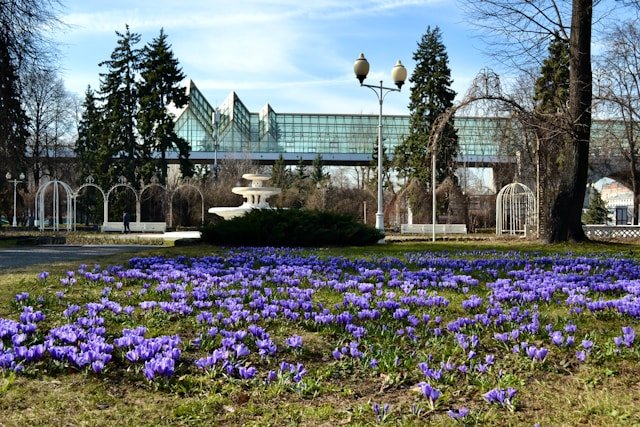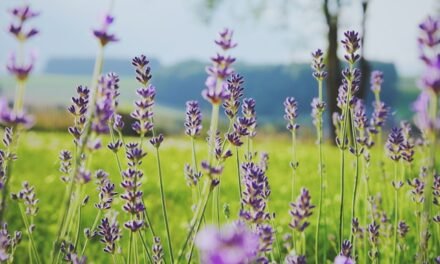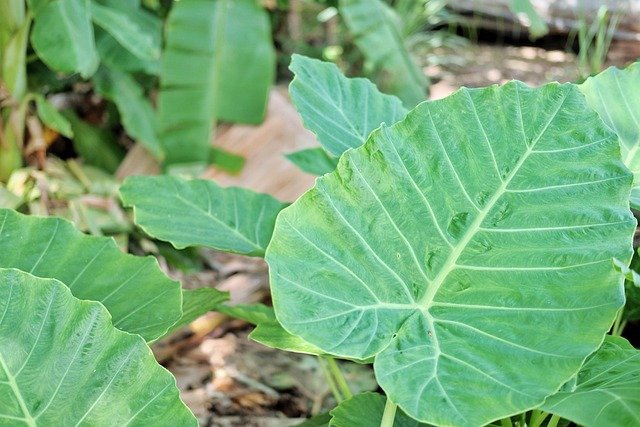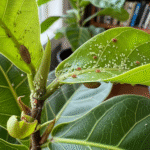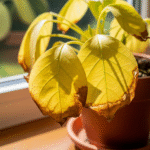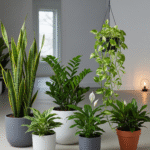In the realm of gardens and landscape decoration, there are few things that could as successfully induce a sense of drama, mightiness, and splendor as the gorgeous purple leaf plants that are used in outdoor regions. These botanical wonders add a very enchanting colour to gardens, parks and even landscape, giving them a majestic feel that is completely irresistible unto a viewer. With their layers of dark violet that range from eggplant to amethyst, purple leaf plants become ideal accent pieces, standing out brilliantly against backgrounds of green, and caught by one’s senses as sights that delight and stir one’s imagination. We will step right into these lovely botanical wonders today to discuss their general features, from leaves to growth habits and much more in the form of outdoor landscape treasures that make them such beloved gems.
General Features of Outdoor Purple Leaf Plants:
Foliage Diversity:
Certainly, the abundance of variously shaped big and small leaves is one of the most amazing features of outdoor purple leaf plants. These specific plants range from broad, heart-shaped leaves to finely shaped fronds, exhibiting leaf varieties and textures that give them their distinct purposes. Make a place for the purple leaf plants whose leaves come in various sheen and textures, and which are covered with velvety hairs or delicate veining. These plants add color and life to your outdoor setting.
Color Variation:
Although you may imagine gorgeous deep and dainty purples when you hear the word “purple leaf”, the spectrum of the hue of living plants is so much more diverse. According to their kind and variety, these plants may express plum, burgundy, magenta or metallic purple hues bringing the spectrum of colors onwards and creating a dazzling effect in the nature and enriching the landscape with their stunning presence.
Seasonal Transformations:
One of the joys of gardening purple plants outdoors is the opportunity to follow their seasonal changes during the year. Starting with the delicate, spring foliage in the echoing shades of purple then when the summer comes it’s velvety leaves bathing in the sun’s love, these plants undergo transformational metamorphosis which occurs in such a way that the surroundings are dotted with changes of beauty and colors throughout the seasons.
Versatile Landscape Applications:
They can be used as just ornamental specimens or as centerpieces in garden beds or as dramatic accents for container gardens. There is a lot of creative options in landscape design from these. Their vibrant colors and outstanding foliage make them great for pairing with a diversity of other plants, providing contrast, texture, and eye-catching aesthetics to all types and sizes of gardens.
Let’s move forwards on our journey and take a step towards the various types of outdoor purple leaf plants:
The indoor art of plants has its own charm, but nothing beats the vibrant world of outdoor purple vegan plants. With this in mind, let us explore the different species and cultivars that make our outdoor spaces more intriguing with their lovely shades and alluring beauty. From the beautiful Japanese maples leaves to the falling tendrils of sweet potato vines, every plant offers a textured masterpiece of colors, that you can touch, that calls us to get lost in the timely appeal of nature. Hence, let us equally launch this expedition hand in hand on the path of curiosity and intrigue as our eyes scope the boundless scenarios that come to life in the outdoor purple leaf plants’ domain.
Purple Fountain Grass (Pennisetum setaceum ‘Rubrum’):

Pennisetum setaceum ‘Rubrum’ commonly known as Purple Fountain Grass is an aesthetic plant prized for its arching round shape leaves and attract grabbing purple-red color. This plant which is from tropical and subtropical places, now days many people like to plant this for its beautiful visual appearance and little care. The Purple Fountain Grass is a small upright growing plant with an intriguing cascade of leaves which makes it a very eye-catching decorative element in gardens, borders and container plantings, guaranteeing it as a versatile means of enriching the outdoor spaces.
Majestic Features of Purple Fountain Grass:
- Elegant Foliage: The arching blades of Purple Fountain Grass flaunt an admirable, purplish-black shade that gives your garden a touch of class.
- Graceful Form: The responsible flow and the curved stems of this ornamental grass make it float gracefully under a summer breeze, hence a scene that has a soothing and dazzling beauty.
- Alluring Plumes: By the late summer and early fall, you will see silky bottlebrush-like plumes of Purple Fountain Grass emerge in shades of bushy burgundy to a soft creamy white, and their feathered form will surely add a creative, fanciful touch to your garden.
- Drought Tolerance: This grass is adapted to arid and semi-arid climates; it is drought-tolerant even when it has been rooted in; therefore, it is an excellent choice when designing landscapes reserved for water.
- Low Maintenance: Due to low maintenance needs, it becomes the perfect plant for gardens and landscape as it is rarely attacked by pests and diseases.
User-Friendly Features of Purple Fountain Grass:
- Easy to Grow: As long as the soil is well-drained, this grass can grow quite well in a number of soils.
- Versatile Use: This variety finds its use both in borders, mass plantings, containers, ornamental displays. This is confirmed by its range of different applications which allow more flexibility and creativity in the design process.
- Minimal Pruning: For its neat, compact shape with little pruning requirements, Purple Fountain Grass is a perfect choice for gardeners with little time to trim.
- Wildlife Attraction: The woolly plumes of Purple Fountain Grass made pollinators such as butterflies and the bee hover around, in other words, the diversity in our garden is increasing as well as the community where these organisms live.
- Seasonal Interest: No wonder Purple Fountain Grass is popular for its rich foliage and intriguing structure, but the plant shows its appeal through the whole growing season with the beautiful plumes, too.
Irritating Features of Purple Fountain Grass:
- Invasive Potential: In some areas Purple Fountain Grass can be aggressive and invasive, rapidly spreading, displacing native plants, and as a consequence posing a threat to biodiversity and ecosystem health.
- Susceptibility to Frost: Whereas the Purple Fountain Grass is hardy in USDA zones 8-11, it may get damaged or die back in colder climates, hence the need for protection or replanting in spring for its rejuvenation.
- Seed Dispersal: High seed-production ability of the improved Purple Fountain Grass variety can lead to unfavorable seed-shelfing and wide dispersal thus necessitating removal of flower head to curb the sprouting of unwanted seedlings.
- Limited Cold Tolerance: Although it is drought-tolerant, the Purple Fountain Grass is prone to problems in areas where there is considerable frost or where temperatures drop below zero, which might need protection or overwintering inside.
- Potential for Flopping: In the locations subject to the winds or the exposure you may find the arching stems of the Purple Fountain Grass to be floppy or bendy, which do not give it the upright and neat form.
Conclusion:
In the end, Purple Fountain Grass (Pennisetum setaceum ‘Rubrum’) can be considered as the ideal choice for anyone who wants to add beauty, resilience, and versatility to his environment. From the beauty of its leaves and its swaying forms to its practically zero maintenance and the fact that it attracts wildlife, this ornamental species is an impressive sight and a delight to all of the five senses! Although it has some disadvantages like growing invasively or frost susceptibility in some areas, the charm of the Purple Fountain Grass simply cannot be ignored, and it calls all gardeners and landscapers out there to enjoy its grandeur and embrace the eternal beauty of nature.
Purple Smoke Bush (Cotinus coggygria):
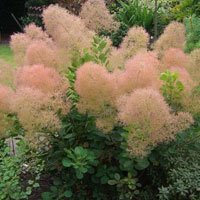
Purple Smoke Bush (Cotinus coggygria), situated within the family of deciduous shrubs, is a mesmerizing plant known for the magnificent clouds of smoky purple foliage. Coming from Eurasia, this plant with ornamental value is not just a favorite of gardeners and landscapers but would also be a dramatic visual tool and function as a versatile element in garden design. With its vibrant foliage and striking architectural form, Purple Smoke Bush adds a touch of mystique and allure to gardens, borders, and mixed plantings, making it a cherished addition to outdoor landscapes.
Majestic Features of Purple Smoke Bush:
- Ethereal Foliage: The foliage of a Purple Smoke Bush emerges in a rich deep purple colour which suits the surrounding smoke effect it creates in a garden and makes it a good choice for the garden landscape.
- Dramatic Plumes: In late spring to early summer Purple Smoke Bush gives rise to white, fluffy panicles in the shape of cloud, which surround the plant with an aura of delicate smokiness, pervading it with a note of romantic intrigue.
- Architectural Form: By its upright growth, and the open, wide-spread branches, Purple Smoke Bush forms a dignified silhouette which makes it a great focal point in a garden border or flower bed.
- Seasonal Color: Throughout the entire process of the growing season, Purple Smoky Bush is colored in kaleidoscope of transformation, from the deep purple of spring to that of the fall which is orange and scarlet, offering us year around interest and beauty in color.
- Drought Tolerance: Drought tolerance of Purple Smoke Bush is quite high once the bush is well established which makes a perfect shrub for drier, arid climates or water-wise landscapes.
User-Friendly Features of Purple Smoke Bush:
- Easy to Grow: The Purple Smoke Bush easily adapts to different soils of various types as long as they are well drained.
- Low Maintenance: The purple smoke bush requires little complex pruning or care, is virtually free from pests and diseases, hence is suitable for low-maintenance landscapes and gardeners that are on the go.
- Wildlife Attraction: The fluffy blooms of the Purple Smoke Bush act as the flowers that attract pollinators such as the butterflies and bees that aid in raising the biodiversity of the garden and serve the local ecological systems.
- Versatile Use: Its forms of specimen plantings and focal points, mixed borders and mass plantings are of innumerable landscape applications. Purple Smoke Bush has a variety of purposes, giving more meaning and liberty to the purpose.
- Hardy Nature: Purple Smoke Bush is hardy to USDA zones 5-8 and it is a great option for all types of climates, from temperate to semi-arid regions.
Irritating Features of Purple Smoke Bush:
- Invasive Potential: In some regions, Purple Smoke Bush can self-seed and invade aggressively, even getting into the invasive rank if not held in check with native vegetation.
- Pruning Challenges: Although Purple Smoke Bush rarely needs pruning to keep it well looked after, its vigorous growth habit and suckers, which do form, may result in difficulties when forming or rejuvenating large specimens.
- Leaf Drop: In the periods of drought or water stress Purple Smoke Bush may lose its leaves before time, which is unappealing and may need additional watering or care.
- Susceptibility to Disease: Although rather durable, Purple Smoke Bush can get the fungal diseases like powdery mildew in humid or poorly ventilated conditions, hence measures should be taken in advance, or the treatment should follow.
- Limited Cold Tolerance: Despite the fact that it is hardy in USDA zones 5-8, Purple Smoke Bush can be damaged or even freeze back in case of very cold weather or extreme winter conditions, and for its survival, it requires protection or replanting in the spring.
Conclusion:
To close, Purple Smoke Bush (Cotinus coggygria), is a majestic work of art, representing the beauty and tenacity of nature, with its luminous foliage, striking plumes, and adaptable nature in the garden. Although its invasive disposition from time to time and occasional maintenance difficulties might be a source of worry for some, the irresistible beauty of Purple Smoke Bush remains undiminished, becoming an attractive force for those who appreciate its elegance and wonder hence celebrating Purple Smoke Bush’s perpetual splendor. It is not without reason that a Purple Smoke Bush can become the decoration of a garden bed, a border, or a mixed planting, for its colorful leaves leave a lasting impression on the heart and soul, turning nature into an everlasting canvas in brilliant colors.
Purple Heart Vine (Setcreasea pallida):
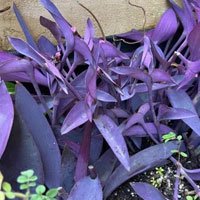
Setcreasea pallida, the scientific name for Purple Heart Vine, captivates with its purple foliage and trailing appearance to add beauty and majesty to landscape décor. Native to the lands of Mexico, this perennial herbaceous vine is now sought after to create that exotic touch to landscapes, hangers baskets, or container plants. This specimen of Vine not only has an eye-catching color but also can be taken care of easily, which makes it look like a star not only in the garden but also in the houses of plant lovers.
Majestic Features of Purple Heart Vine:
- Vibrant Foliage: The leaves of this plant are an intense shade of purple, which acts to create a bold contrast in any surroundings and is a striking visual feature.
- Trailing Growth Habit: Its tresses and cascading foliage, Purple Heart Vine makes a lovely mound or cascade, and with it the garden offers movement and fluidity, whether it is a garden bed, a hanging basket, or a container garden.
- Drought Tolerance: Purple Heart Vine has a high drought-tolerance once fully established and therefore serves well in dry, arid habitats and moisture wise landscapes.
- Easy Propagation: The planting of Purple Heart Vine is very simple since it only requires cuttings of stem from which gardeners can propagate and enhance their collection as well as share this piece of beauty and charisma with other people.
- Seasonal Interest: With bright leaves throughout the year, Purple Heart Vine may, however, produce small insignificant pink flowers in summer adding a delicate text to its leaves already in the spotlight.
User-Friendly Features of Purple Heart Vine:
- Low Maintenance: Suitable for gardeners with both little time to care about plants and lacking experience, the Purple Heart Vine is resistant to both pests and diseases, so it is a good option for them.
- Indoor Adaptability: This plant is a perfect houseplant because it will brighten the indoor living spaces such as living rooms, offices, and sunrooms, thus acting as a retention in a hanging basket or being the cascade over the shelves.
- Versatile Use: Whether as ground cover in garden beds or accent plants in rock gardens and vertical displays in hanging baskets, containers, or the like, Purple Heart vine is extremely versatile with regard to design and application.
- Tolerant of Various Soil Types: Purple Heart Vine is very adaptable to a variety of soil types, whether it is sandy to loamy, but what it needs is well drained soil, providing it with the opportunity to be flexible and grow anywhere.
- Wildlife Attraction: Although its principal function is decoration, the Purple Heart vine may act as a pollinator attractor when in bloom, thus uplifting the biodiversity of the garden ecosystem.
Irritating Features of Purple Heart Vine:
- Invasive Potential: This plant’s associability is undesirable in certain areas. It spreads quickly and displaces the indigenous plants, especially under its favorable growth conditions.
- Susceptibility to Overwatering: In spite of its drought tolerance, Purple Heart Vine can still rot at its root due to too much water or rotten soil, hence people need to pay attention to how they water this plant.
- Winter Sensitivity: Purple Martin Vine may present freezing or leaf yellowing in cold winter areas, but it can be easily protected with earthen mounds or overwintered indoors to ensure its survival in colder regions.
- Legginess: Routine pruning or pinching back is crucial to ensure vigor, or the plant may become woody or sparse looking, decreasing its lush, full-bodied growth habit and hence the overall charm.
- Limited Edibility: Although the literature reveals that some parts of the Purple Heart Vine are edible, and it can be used for medical purposes, the individuals sensitive to it should be very careful and avoid eating it because it could result in vomiting or allergies.
Conclusion:
In sum, Purple Heart Vine (Setcreasea pallida) serves as a mesmerizing embodiment of the dazzling ability and strength inherent in nature, being like a magical spell thanks to its vibrantly green leaves and trailing growth pattern. Even though worries exist like being clingy and overwatering, the Purple-Heart Vine looks very charming and alluring, tempting anybody to enjoy its beauty and pay a homage to the centuries-old elegance of this plant. Regardless of whether it cascades from the edge of a garden wall, spills out of a hanging basket or simply adorns the indoors with its draping foliage, the living legend that is Purple Heart Vine is capable of creating memories that will stay with you forever, it is through this story woven with color and texture that the beauty and enduring magic of nature speaks to us!
Purple Leaf Plum (Prunus cerasifera):
The Purple Leaf Plum, also known scientifically as Prunus cerasifera, is a decorative deciduous tree sought after for its striking purple foliage and the flowering that starts in the early spring. Regarded as an Asian native, this highly ornamental tree is a common choice among gardeners for its attractive beauty and practicing ease. Due to the small size and flexibility of growing conditions, the Purple Leaf Plum gives a color and grace to gardens, landscapes, as well as urban areas, making it a favorite feature in the outdoor spaces.
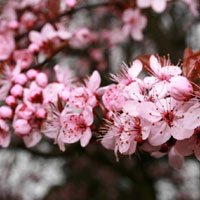
Majestic Features of Purple Leaf Plum:
- Vibrant Purple Foliage: The iconic characteristic of Purple Leaf Plum is its dark purple foliage that creates a contrastive scene in the garden and sticks out amongst the green of the other plants.
- Early Spring Blooms: At the beginning of spring this variety of plum (Purple Leaf Plum) blooms with beautiful pink or white blossoms that cover the branches with a variety of colors and gentle aroma, inviting bees and butterflies and pleasing the senses.
- Ornamental Fruit: Later into the spring, Purple Leaf Plum produces small purple berries which will ripen into a deep reddish-purple color, offering more visual interest and wildlife attraction including birds and squirrels.
- Compact Growth Habit: The growth of a Purple Leaf Plum is typically into a rounded compact form, so that it’s good for small gardens and narrow spaces and even can be planted in containers where space may be limited.
- Drought Tolerance: Once the tree is well established, it requires very little maintenance and is able to adapt to drought conditions showing good drought tolerance making it more suitable for low maintenance landscapes and waterwise gardening practice.
User-Friendly Features of Purple Leaf Plum:
- Easy to Grow: The purple leaf plum is fairly easy to grow and can do well on a lot of different soils, including clay, loam, or sandy soils provided they are well drained. This means that it is suitable for both novice and veteran gardeners.
- Tolerant of Pollution: Purple Leaf Plum is resistant to industrial pollution and does well in city areas, showing it to be suitable for street planting, parks, and other urban spaces.
- Low Maintenance: Pruning and care are barely needed which makes Purple Leaf Plum also relatively pest and disease-resistant, making it versatile for a low-maintenance garden and gardeners’ with busy schedules.
- Cold Hardy: Purple Leaf Plum is cold hardy and can handle at least a subzero climate, so it is a good plant to use in temperate countries and northern regions where winter nights can get as cold as freezing.
- Versatile Use: Purple Leaf Plum can be used as a specimen, focal point in the landscape or as a cluster for added visual appeal, thus allowing one to create a lot of possibilities in artistic garden designing.
Irritating Features of Purple Leaf Plum:
- Messy Fruit Drop: The colorful fruits of the Purple Leaf Plum are designed to beautify the tree but can add up to a lot of mess and therefore leave walkways, driveways, or outdoor living areas, clean up.
- Prone to Pests: When it comes to Purple Leaf Plum, there are some issues that can be caused by pests like aphids, scale insects and caterpillars. If not kept in check, the pests can destroy the foliage causing further damage. Hence, vigilance and management should be maintained.
- Susceptible to Disease: The Purple Leaf Plum can be prone to fungal infections especially leaf spot and powdery mildew when exposed to humid and poor air circulation, which also require treatments or preventive measures.
- Limited Lifespan: The Purple Leaf Plum has a short life expectancy, which is less than in most other tree species, usually it does not live longer than 15-25 years, after which it can lose vitality and start to show signs of decline.
- Invasive Potential: In some regions, Plum Purple might manifest themselves invasively and expand rapidly through self-seeding, hence displacing native vegetation and disrupting the local ecosystems.
Conclusion:
To sum it up, Purple Leaf Plum (Prunus cerasifera) is a incredible species with a variety of uses that provides people with a blast of purple colour, relatively soon pink and white flowers, and delicious, showy fruits. However, the possibility of messy fruit drops and susceptibility to pests and diseases are the only challenges of this temperament. Nevertheless, the appeal of this fruit makes it irresistible to the gardeners and in return they embrace its beauty and include it in their outdoor spaces. Urban or suburban areas, natural parks or domestic gardens, where the trees are planted alongside streets or as the focal point do not matter, all that matters is the sense of emotion that the tree brings, the sense of captivating beauty and timeless impression.
Purple Majesty Ornamental Millet (Pennisetum glaucum ‘Purple Majesty’):
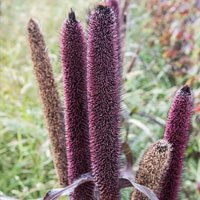
The ornamental millet Purple Majesty, scientific name Pennisetum glaucum ‘Purple Majesty’, is a striking annual plant valued for its purple foliage, and a distinctive shape. Africa is the original place where this decorative grass is from. The reason why it is very loved by gardeners and landscapers is because of its striking presence and adaptability in garden design. The unique color and shape of Purple Majesty Ornamental Millet bring a burst of energy and glamour to gardens, containers and flower beds. Thus, Purple Majesty Ornamental Millet has become highly popular among gardeners, because of its ability to introduce visual interest and texture to outdoor spaces.
Majestic Features of Purple Majesty Ornamental Millet:
- Deep Purple Foliage: The Purple Majesty Ornamental Millet is distinguished mainly by the intense dark purple leaves but can stand against various flowers and greenery plants in the garden.
- Architectural Form: Its strong growth habit that holds foliage in an erect position and its dense texture create an impressive appearance which beneficially helps in adding height in garden beds and borders.
- Showy Plumes: From late summer to early autumn, the Pyramid-like bracts of the Purple Majesty Ornamental Millet flowering head sway with soft purple plumes, creating assorted and lovely landscape.
- Drought Tolerance: Purple Majesty Ornamental Millet is quick to establish itself with impressive drought tolerance and is therefore a good fit for hot/dry climates and water-wise gardening.
- Low Maintenance: It requires low care and maintenance, so it makes it a beneficial choice for those looking to keep low-care yards and ornamental landscapes or beginning gardeners. Furthermore, the plant is quite pest and disease-resistant, which makes it an ideal candidate for those who are looking for a low-maintenance landscape.
User-Friendly Features of Purple Majesty Ornamental Millet:
- Easy to Grow: Purple Majesty Ornamental Millet grows easily from seeds and, regardless the soil type (clay, loam or sandy), it is suitable for both those starting in the garden and the most prehensile gardener.
- Versatile Use: Purple Majesty ornamental millet is suitable for a variety of gardens, such as flowerbeds, garden borders, containers, and mixed plantings, enabling the gardener to choose the best setting for purple ornamental millet.
- Heat Tolerance: The Purple Majesty Ornamental Millet does great in hot and sunny conditions, hence it can be suitable for gardens that are in warm climates and sunny areas where other plants may fail to flourish.
- Wildlife Attraction: The bright red plumes of Elegance Flamingo Ornamental Millet serve as an attraction to pollinators like bees and butterflies, which, in turn, contribute to the biodiversity of the garden and support local wildlife.
- Long-lasting Color: Deep purple foliage of Purple Majesty Ornamental Millet retains its color for the entire season, offering visual appeal and color in the garden throughout the year.
Irritating Features of Purple Majesty Ornamental Millet:
- Invasive Potential: Some regions, however, can show Purple Majesty Ornamental Millet have invasive behavior and tends to self-seed too much, which, in case of not being managed properly, may become weedy and displace native vegetation.
- Limited Lifespan: The Purple Majesty Ornamental Millet is an annual grass that grows for one growing period. Therefore, it will require reseeding in each autumn to retain its presence in the landscape.
- Messy Plumes: The lacy plumes of Purple Majesty Ornamental Millet will lend a great texture and interest to the landscaping while they are still fresh and with seeds intact, but they might become messy when they dry out, requiring some re-tidying in patio or decks.
- Potential for Flopping: Windy or open locations may blow or bend Purple Majesty Ornamental Millet onto the ground, when strong gusts occur, spoiling the upright shape and the visual impression of the whole plant.
- Prone to Diseases: Purple Majesty Ornamental millet which is usually resistant to these fungal diseases can also be susceptible to diseases such as leaf spot and rust in some humid or ventilating conditions and therefore calls for preventive measures or treatments in order to maintain its healthy growth.
Conclusion:
In summary, Purple Majesty Ornamental Millet (Pennisetum glaucum ‘Purple Majesty’) is an impressive and multi-purpose plant that is worthy of all attention for its majestic purple colour, myriad of forms, and attractively thick plumes. Although, the challenges associated with invasiveness and disease susceptibility are the reasons to consider carefully, the appeal of the plant to be gardeners is overwhelming, driving them to the plant’s beauty that has made many to include it in their gardening blossom. Whether used as the center pin of landscape beds, edging the flowering containers, or bringing texture to the mixed plantings, Purple Majesty Ornamental Millet makes every heart and soul wonder, highlighting the landscape with its stunning colours and classical beauty.
Purple Ninebark (Physocarpus opulifolius ‘Diablo’):
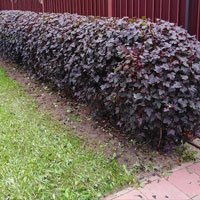
The Curly Stemmed Ninebark (Physocarpus opulifolius ‘Diablo’) is a spectacular deciduous shrub that is valued for its lavish foliage and elegant shape. Developed in the US, this cultivar has distinctive deeply pigmented leaves and gracefully arching limb growth that create magnificent foliage, flower bed, fence, or combined arrangements. Featuring its versatility in different planting sites as well as its low upkeep needs, Purple Ninebark ‘Diablo’ has won over the hearts of gardeners and landscape designers who are looking to add an eye-catching visual appeal to their garden or park.
Majestic Features of Purple Ninebark:
- Dramatic Foliage: The foliage of Purple Ninebark ‘Diablo’ is a very rich, dark purple color that maintains its coloring throughout the entire growing season, giving it the visual appeal needed to contrast other greenery and flowers.
- Elegant Form: Its upturned branches and drooping foliage, both adding height and structure to garden beds or borders, makes plants like Purple Ninebark ‘Diablo’ look beautiful and elegant. They can give a sense of splendor and solemnity to the whole picture.
- Seasonal Interest: Apart from its striking leafy color, Purple Ninebark ‘Diablo’ also grows small white flowers in late spring to early summer, and then continues to have the seed capsules of a red color in fall, providing generous visual interest all year round.
- Wildlife Attraction: The flowers and the seed capsules of Purple Ninebark ‘Diablo’ attract pollinators such as bees and butterflies, which in turn, contribute to the biodiversity of the garden ecosystem, which cements its place in nature.
- Versatile Use: From single specimen plantings and focal points to mixed borders and mass plantings, the Diablo variety of the ninebark can be incorporated in a wide range of landscape designs, thus providing flexibility and versatility in design.
User-Friendly Features of Purple Ninebark:
- Easy to Grow: Purple Ninebark ‘Diablo’ is an easy to grow and adaptable plant to all soil types; clay, loam, and sandy soils. Therefore, it suits many garden environments.
- Low Maintenance: Another advantage of this plant is its negligible pruning requirement as well as resistance to pests and diseases. Thus, it is perfect for everyone from experienced gardeners to just beginning their green thumb adventures.
- Drought Tolerance: Once established, Purple Ninebark ‘Diablo’ is proven to be drought tolerant, so it’s a successful match for arid conditions and water-wise garden plans.
- Hardy Nature: Purple Ninebark ‘Diablo’ works well in the hardiness zones 3-7 it calls for low temperatures and forbidding winter conditions. Therefore, it is suitable for when the climate is temperate and for the northern regions.
- Tolerant of Pruning: Purple Ninebark ‘Diablo’ is a great option as it belongs to a group of plants, which tolerate pruning very well. Therefore, it can be trimmed and shaped to fit the garden design reducing the maintenance in the long run.
Irritating Features of Purple Ninebark:
- Invasive Potential: In some places, the cultivar ‘Diablo’ should be checked due to invasive inclinations that can spread quickly with suckering and should be managed regularly to avoid overcrowding and competition with other plants.
- Sporadic Suckering: The invasive species, ‘Purple Ninebark ‘Diablo’, benefits from warm climates producing suckers occasionally throughout the growing season, which needs pruning to be diligently done to keep unwanted growth at hand and for a neat look.
- Potential for Disease: Purple Ninebark ‘Diablo’ is mostly resistant but may be attacked by fungus diseases such as powdery mildew and leaf spot in humid and badly ventilated conditions that need protective measures or medication.
- Leaf Drop: If a sudden loss of viability occurs, or in other words, if some kind of stress or abrupt environmental changes occur, ‘Diablo’ Purple Ninebark might experience early leaf drop which can conceal its satisfactory visual effect and could be a reason for additional maintenance or care.
- Limited Flowering Period: Although clusters of white flowers can be seen on Purple Ninebark ‘Diablo’, their life cycle if fairly short with the flowers fading out rather quickly, and then being replaced by the seed capsules.
Conclusion:
In the end, Purple Ninebark (Physocarpus opulifolius ‘Diablo’) qualifies as a stunning component of any landscape, mesmerizing people with the striking beauty of its leaves, gracefully architectural shape, and seasonal interest. Nonetheless, the plot should not be considered with neglecting questions such as invasive tendencies and sporadic suckering, but the allure of ‘Diablo’ Purple Ninebark is still irresistible, thus, at gardeners’ and landscapers’ choice the beauty of this celebrated ornamental shrub should be truly expressed. Whether it’s the gorgeous borders or the illuminating interweaved patterns, purple ninebark bloom expresses a unique emotion and contains the intriguing allure of the nature’s beauty.
Purple Coral Bells (Heuchera spp.):
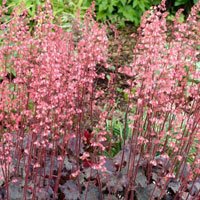
Purple Coral Bells, of the genus Heuchera, are world-renowned due to its stunning foliage and delicate bell-shaped flowers. They are North American native plants and gardening enthusiasts collectively appreciate them for their versatility and ornamental beauty. Multiple types of cultivars are available, and Purple Coral Bells can display an array of foliage colors that moves from deep purples to intense greens. As such, they are an excellent choice to add texture and interest to your garden beds, borders, and pots. Also, their small size and relatively easy manageability make them suitable for amateur and experienced gardeners.
Majestic Features of Purple Coral Bells:
- Striking Foliage: The purple Coral Bells varieties are known for their colorful foliage that can range from deep purple to burgundy or bronze and thus can enliven any garden with a flashy addition of vivid tones.
- Delicate Flowers: Throughout late spring to early summer, the small bell-shaped flowers of Purple Coral Bells, in a wide range of colors such as pink, white or coral, emerge at the ends of long slender stems forming blooming clusters, that attract pollinators, and, at the same time amaze with their elegance and beauty.
- Compact Growth Habit: They have a compact size and a mounding growth habit, so they can be grown along pathways, borders and mixed plantings as edging, border lining or filling in those gaps. Their appearance is neat and tidy.
- Long-lasting Color: The upright foliage of the Purple Coral Bells retains its color, providing both year-round interest and ornamental value.
- Versatile Use: One of this plant’s best features is how versatile it is. It can be grown in a wide range of settings, from a shaded woodland to a rockery in full sun, and it also is well-suited to containers, hanging baskets, and vertical gardens, offering endless possibilities for creative design.
User-Friendly Features of Purple Coral Bells:
- Shade Tolerance: Phloxes with a purple hue do very well in partial to full shade and are an excellent option for gardens with little sunlight or shaded places under trees and shrubs.
- Low Maintenance: Simple to grow and maintain, these Purple Bells are generally resistant to pests and diseases which means they are perfect for busy gardeners and landscapes that don’t need a lot of work.
- Drought Tolerance: Being the drought tolerant performers, they have good drought tolerance which reduce the need for frequent waterings and, in turn, suit for the water wise gardening practices.
- Deer Resistance: There are multiple Purple Coral Bells varieties that are resistant to the deer’s grazing, thus are perfect choice for gardens in deer-prone zones.
- Easy Propagation: The purple Coral Bells can be either divided or removed and propagated, thus increasing one’s garden collection and sharing their beauty with others.
Irritating Features of Purple Coral Bells:
- Susceptibility to Crown Rot: Crown rots if planted at too deep depth or in poorly drained soils, rotting of the crown and the resultant decline of the plant happen to these types of bells.
- Limited Flowering Period: Of course, while the flowers of Purple Coral Bells are delicate and attractive, the flowering period is relatively short-lived, and the blooms last only few weeks, in late spring to early summer.
- Sensitive to Overwatering: These plants can also rot at the roots under waterlogging or soggy soil conditions, which are overwatering spells.
- Invasive Spread: There may be a reason for some of the hybrids of the Purple Coral Bells to form aggressive spreads through the rhizomes, which may push other plants out of the garden if care to look after is not rightly utilized.
- Foliage Discoloration: The purple leaves of Purple Coral Bells can turn pale or burn if the plant is exposed either to too much light or heat in hot, humid climates. This can diminish its overall appeal.
Conclusion:
In brief, Heuchera spp. sis the plants that are very beautiful and ornamental in the gardens offering the wonderful green color of leaves, charming flowers, and the possibility to grow in different conditions that are typical of gardens. Despite some of the possible drawbacks including the susceptibility to crown rot and the limited flowering period, the aura of the Allure of Purple Coral Bells remains undeniable making many gardeners embrace their beauty and use them as decorative plants in their yards. Be it used in borders as accents on a shaded area, underscoring woodland gardens, or as a focal point in potted plantings, Purple Coral Bells are adding liveliness and tenderness to the garden, enhancing it with their intense colors and attractive presence.
Purple Japanese Maple (Acer palmatum):
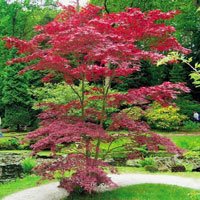
Purple Japanese Maple, Acer palmatum as its scientific name, is a charming deciduous tree admired for its refined and magnificent purple foliage. Originating from Japan, this showy tree has become the apple of both gardeners and landscapers eyes, as it naturally presents a graceful silhouette and vivid colors. The Purple Japanese Maple with its delicately balanced leaves and sophisticated upright branches brings dignity, style, and beauty to both private gardens, parks and landscapes, being much valued as part of the outdoors.
Majestic Features of Purple Japanese Maple:
- Exquisite Foliage: The Japanese Maple in Purple is one of the trees that are well known for their dazzling green leaves that appear in various shades ranging from dark purple to dark red, standing out in a garden among other greenery.
- Graceful Form: With its elegant branches and beautiful cascade, this Purple Japanese Maple becomes a tall attractive silhouette that serves to accentuate garden beds and borders and provides elegance and sophistication to the landscape.
- Seasonal Color: The purple Japanese maple goes through a series of color changes all through the growing season starting from burgundy in spring and ending in shades of orange and red during fall thus being advantageous for both spring and fall landscape.
- Architectural Interest: The cascading canopy of Purple Japanese Maple provides horticultural merit to the landscape, forming a visual hub for anyone to seek.
- Versatile Use: Living up to the name by exhibition in specimen plantings and focal points, in mixed borders and in container plantings, Purple Japanese Maple is extremely adaptive in landscape design, providing flexibility and variety.
User-Friendly Features of Purple Japanese Maple:
- Adaptable to Various Soil Types: Purple Japanese Maple prefers a variety of soil types such as loamy, sandy and clay but is only productive in well-drained soils, so it is a good plant for diverse garden landscapes.
- Tolerant of Part Shade: The Purple Japanese Maple can be happy with the partial sun to the full one, but it is adaptable to different conditions of light which gives the possibility to place it anywhere in the garden.
- Low Maintenance: With the least pruning and care degree in contrast to other maple trees, the Purple Japanese Maple is also pest and disease resistant, hence suitable for low maintenance landscapes and starting gardeners.
- Dwarf Varieties Available: Dwarf cultivars of Purple Japanese Maple are being introduced, which are good options for smaller gardens, patios, and container planting, and for people who struggle with planting larger species.
- Longevity: With good care Purple Japanese Maples can live for decades, and you can enjoy the garden for years.
Irritating Features of Purple Japanese Maple:
- Sensitive to Heat and Drought: The Purple Japanese Maple is delicate in heat and drought stress and may show such symptoms as leaf scorch or dieback if no water is supplied and the tree is kept out from the excessive sunlight.
- Susceptible to Leaf Burn: In windy or well-exposed environments, the lavender maples might likely scorch or suffer from leaf damage, particularly in a hot or dry climate or during extreme weather conditions.
- Vulnerable to Pests: Although it has a strong resistance to major pests and diseases, Purple Japanese Maple may have aphids, scale insects, and caterpillars as its pests, which if left untreated could lead to damage in foliage.
- Slow Growth Rate: Purple Japanese maple is a tree which has a slow growth rate especially when young it is therefore necessary to have patience and be careful when handling it so that its desirable size and shape are achieved in the landscape.
- Pricey Investment: Larger size Purple Japanese Maple could be costly to buy from marketplace, so it becomes a significant investment for homeowners and landscapers.
Conclusion:
To conclude, the Plum Japanese Maple (Acer palmatum) is a perfect choice as a magnificent and fascinating display in any outdoor landscape as it arrests admiration with its beautiful form, the numerous variations of foliage color and the color changes in seasons. There is the potential of difficulty due to sensitivity to heat as well as drought and also susceptibility to pests even though the irresistible lure of the Purple Japanese Maple cannot be denied, and so gardeners and landscapers are coerced to emulate its beauty and incorporate it into their outdoor environments. No matter where a Chinese Moon Maple plant is placed in the garden whether as a focal point or in a container at the patio, it definitely leaves a lasting impression on the heart and soul that speaks of nature’s elegance through the weft of color and texture.
Purple Trumpet Vine (Campsis radicans ‘Purpurea’):
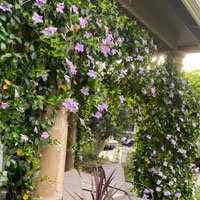
The purple variety of the Trumpet Vine, Campsis radicans ‘Purpurea’, is a plant that many people love for its bright purple blooms and its rich green leaves. Native to North America this vine is granted a great admiration for its pollinators attracting abilities and garden and trellises vertical aesthetics. Its energy, rapid growth, and long-lasting flowers which are beautiful make many gardeners to opt to it as the main focus to create a bold and colorful focal point in their outdoor landscape.
Majestic Features of Purple Trumpet Vine:
- Vibrant Purple Flowers: The most distinctive feature of the Plant of Purple is large trumpet-shaped flowers in the shade of deep purple which attract guests to the garden, be it be butterflies or humming birds.
- Rapid Growth: This Vine presents fast growth rate, so it can quickly cover the arches, trellises and fences with its dense foliage and lots of flowers, thus creating a beautiful and green scenery in the landscape.
- Long Blooming Period: The blooming period of the violet flowers of Trumpet Vine can last from spring up to fall, bringing continuous color and beauty to the garden for months, thus, a fantastic centerpiece throughout the season.
- Drought Tolerance: When established, Purple Trumpet Vine is of low maintenance that need almost no watering and can be adopted in low maintenance landscape and water-wise garden practice.
- Wildlife Attraction: Among the many benefits of the Purple Trumpet Vine, these species also help to feed and shelter birds which in turn create biodiversity of the whole garden.
User-Friendly Features of Purple Trumpet Vine:
- Easy to Grow: Trumpet Vine in Purple has an easy to spread growth habit, and can tolerate whether it is clay, loam, or sandy loam soil, provided it is well drained, allowing it to be grown by both beginners and experienced gardeners.
- Versatile Use: The Coral Honeysuckle is an ideal candidate for climbing up arbors, trellises, fences and pergolas, adding vertical interest to the garden or growing in containers on patios or balconies.
- Low Maintenance: Like other living plants, this vine requires minimal pruning and care. It is resistant to pest infestation and diseases which is why, it is an ideal choice for gardeners who are busy in their day-to-day life and those with low maintenance of landscapes.
- Tolerant of Heat: Purple Trumpet Vine is heat tolerant; it loves full sun to partial shade. Therefore, it can be ideal in warm climate gardens and any place with a sunshine.
- Propagation: The propagation of the purple trumpet vine from stem cuttings is simple and effectively helps in the blossoming of the gardener’s collection and sharing its beauty with others.
Irritating Features of Purple Trumpet Vine:
- Aggressive Growth: Purple Trumpet Vine is invasive. It can spread into the garden and grow over other plants faster than they can.
- Lack of Control: Once the root system of Purple Trumpet Vine is well established, it can be hard to curb this vigorous plant, consequently necessitating regular pruning and maintenance to prevent it from smothering other plants or affecting the landscaping.
- Prone to Self-Seeding: The purple trumpet vine produces plentiful seeds that can freely self-seed as well as germinate in neighboring locations leading to excessive growing seedlings and uncontrolled spread way beyond the boundary delineated for desired vegetative area.
- Potential for Damage: The exogenous roots of the Purple Trumpet Vine can wreak damage to structures and surfaces such as siding, restraints and trees if not pruned or trained accurately.
- Allergenic Potential: The latex of this plant might cause irritations or allergies if you touch it directly; this is why it should be handled with caution.
Conclusion:
In summary, Trumpet Vine (Campsis radicans ‘Purpurea’) is a stately and full of vigor plant that will be the star of any garden or outdoor landscape, presenting a great royal colour, flowering and growing quite fast. While these possible risks like excessive and allergenic sap could prove annoying, the lure of Purple Trumpet Vine is irresistible, beckoning gardeners to marvel at its beauty and find a place for it in their garden. Ranging from trellises, arbors, or fences to patios and balconies, Purple Trumpet Vine brings to landscapes a touch of elegance with it vibrant colors and bountiful blossoms which adds value to the garden.
Grand Conclusion:
Nature itself presents a kaleidoscope of colors, and the outdoor purple leaf plants turn to be the priceless gems that catch your fancy, making the surroundings more colorful. Starting from the magnificent Purple Japanese Maple and Purple Ninebark, these plants interweave colors and stories of awe, beckoning us to delve into garden secrets. Along the way, it is as if you are moving from the deep purples of a Purple Heart Vine on the garden path, and the luxurious hues of Purple Smoke Bush to this magical land where your imagination knows no bounds. Whenever a leaf uncurls or a flower emerges, the plants reminding us that the nature is inexhaustible and invincible are getting purple. Hence, let’s dive in the beauty of these botanical pieces and may our gardens be with us forever decorated by the irresistible appearances of outdoor purple-leaf plants.

